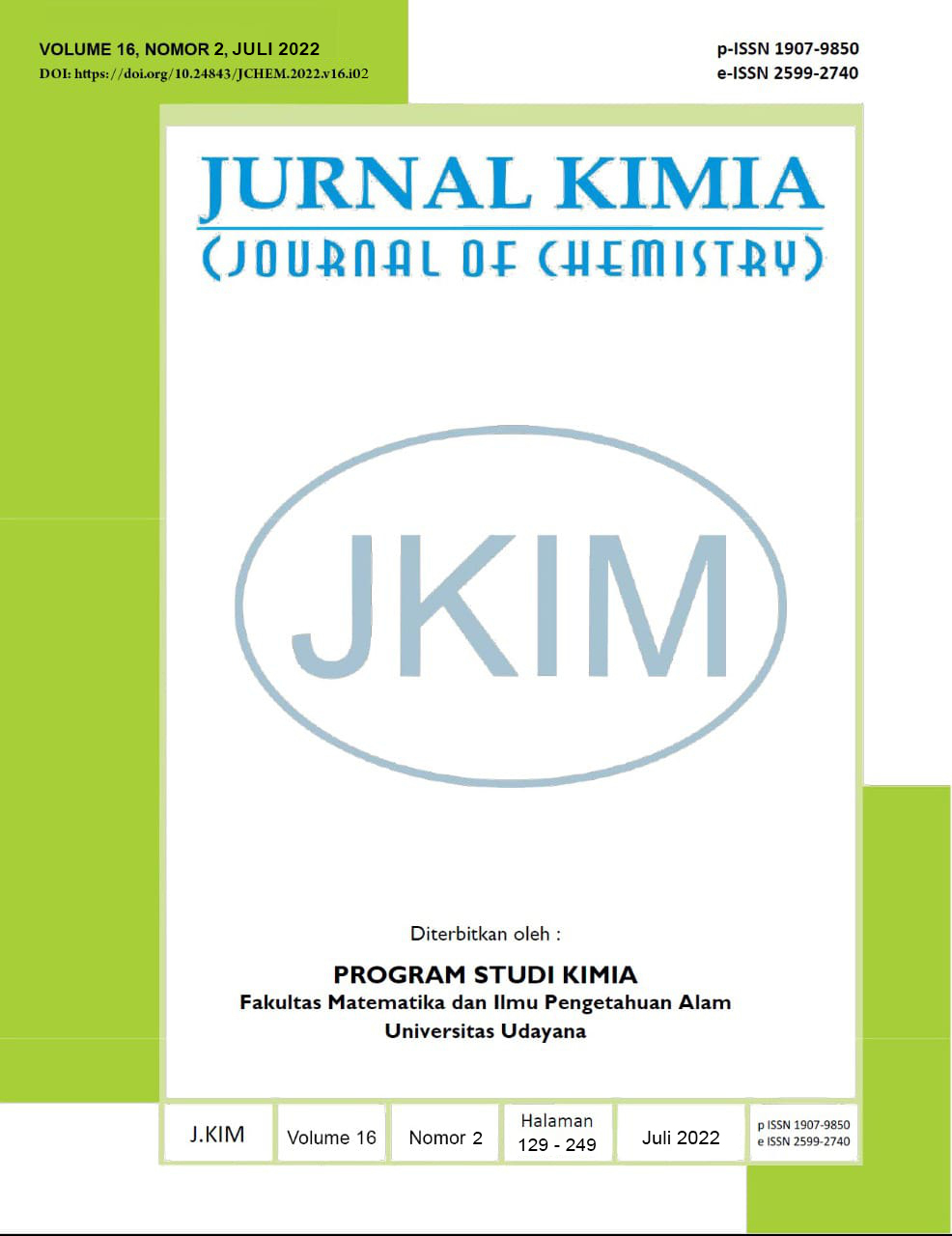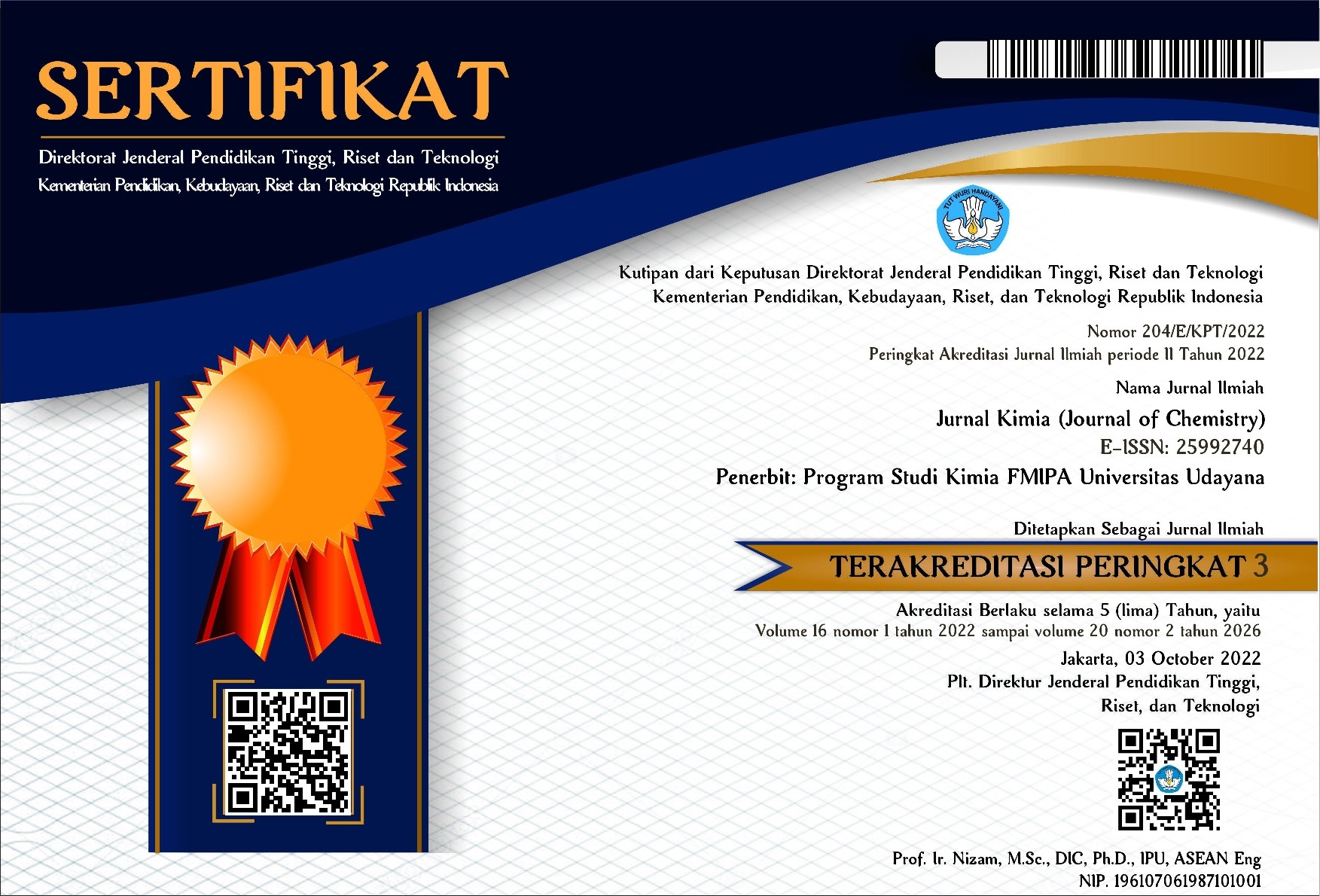MODIFIKASI SILIKA GEL DARI ABU LIMBAH HASIL PROSES PEMBAKARAN INDUSTRI BATU BATA DENGAN DIFENILKARBAZON SEBAGAI ADSORBEN SERTA UJI DAYA SERAP TERHADAP ION LOGAM Cr(III) DAN Cu(II)
Abstract
Modifikasi silika gel dari abu limbah proses pembakaran batu bata dengan difenilkarbazon telah dilakukan. Silika gel termodifikasi difenilkarbazon (Si-DPZon) diperoleh dengan cara mendidihkan abu dengan larutan NaOH untuk menghasilkan natrium silikat dan dinetralkan dengan HCl untuk mendapatkan silika gel kemudian dimodifikasi secara fisik dengan ligan. Kajian yang dilakukan meliputi penentuan gugus fungsi adsorben secara spektrofotometer IR, keasaman permukaan dengan metode titrasi asam basa, luas permukaan spesifik dengan metode metilen biru, kondisi optimum adsorpsi (pH, waktu kontak) Cr(III) dan Cu(II) . Hasil FTIR menunjukkan Si-DPZon mengandung gugus fungsi amida (N-H), karbonil (C=O), silanol (Si-OH), siloksan (Si-O-Si) dan aromatik (C-H). Hasil penelitian menunjukkan bahwa Si-DPZon memiliki keasaman permukaan (Kal) sebesar 5,8384 ± 0,2466 mmol/g, jumlah situs aktif 12,3945x1020 atom/g, dan luas permukaan spesifik 12,6886 m2/g. Si-ABB memiliki keasaman permukaan (Kal) sebesar 4,5568±0,2453 mmol/g dengan jumlah situs aktif 27,4410x1020 atom/g dengan luas permukaan spesifik 11,6712 m2/g. Kondisi optimum adsorpsi krom (III) baik Si-DPZon maupun Si-ABB terjadi pada pH 5 dan 15 menit. Kemampuan adsorpsi Cr(III) oleh Si-DPZon pada kondisi pH dan waktu kontak optimum adalah 34,6927 mg/g dengan persentase adsorpsi 86,7317% dan Si-ABB diperoleh pada 34,5445 mg/g dengan persentase adsorpsi 86,3611%. Kemampuan adsorpsi Cu(II) oleh Si-DPZon pada kondisi pH dan waktu kontak optimum adalah 26,49672 mg/g dengan persentase adsorpsi 66,2418% dan Si-ABB diperoleh 24,93210 mg/g dengan persentase adsorpsi 62,3302%.
Kata kunci: adsorpsi, krom (III), tembaga (II), ligan difenilkarbazon, sintesis silika gel.
ABSTRACT
The modification of silica gel, from the waste of the bricks burning process, with diphenylcarbazone has been done. The silica gel modified by diphenylcarbazone (Si-DPZon) was obtained by boiling the ash with NaOH solution to create sodium silicate and neutralized with HCl to get the silica gel, then physically modified with diphenylcarbazone ligand. The study included the determination of the adsorbent functional groups by spectrophotometer IR, surface acidity by acid-base titration method, specific surface area by absorption of methylene blue method, the optimum conditions (pH, contact time) of the adsorption of Cr(III) and Cu(II). FTIR analysis showed that the Si-DPZon contained amide (N-H), carbonyl (C=O), silanol (Si-OH), siloxane (Si-O-Si) and aromatic (C-H) functional groups. The results showed that Si-DPZon had a surface acidity (Kal) of 5.8384 ± 0.2466 mmol/g with the number of active sites of 12.3945x1020 atom/g with a specific surface area of 12.6886 m2/g. Si-ABB had a surface acidity (Kal) of 4.5568±0,2453 mmol/g with the number of active sites of 27.4410x1020 atom/g and with a specific surface area of 11.6712 m2/g. The optimum conditions for adsorption of chromium (III), both Si-DPZon and Si-ABB occurred at pH 5 and 15 minutes. The adsorption ability of Cr(III) by Si-DPZon at the pH and contact time optimum conditions was 34.6927 mg/g with an adsorption percentage of 86.7317% and Si-ABB was obtained at 34.5445 mg/g with the adsorption percentage of 86.3611%. Adsorption ability of Cu(II) by Si-DPZon at the pH and contact time optimum conditions was 26.49672 mg/g with the adsorption percentage of 66.2418% and Si- ABB was obtained at 24.93210 mg/g with the adsorption percentage of 62.3302%.
Keywords: adsorptions, chromium (III), copper (II), diphenilcarbazone ligand, synthesis of silica gel.
Downloads
References
Azmiyawati, C., 2004, Modifikasi Silika Gel dengan Gugus Sulfonat untuk Meningkatkan Kapasitas Adsorpsi Mg(II), Indonesian Journal of Chemistry, Universitas Gajah Mada, Yogyakarta, 11-17
Hadi, I., Arsa, M., dan Sudiarta, I. W., 2013, Sintesis Silika Gel Dari Abu Sekam Padi dan Abu Limbah Pembakaran Batu Bata Dengan Metode Presipitasi, Jurnal Kimia (Journal of Chemistry), Vol. 7 No. 1.
Huljana, M. dan Rodiah, S., 2019, Sintesis Silika dari Abu Sekam Padi dengan Metode Sol-gel, Prosiding Seminar Nasional Sains dan Teknologi Terapan, Vol. 2 pp. 1-8
Jonathan D. Cuppett, Susan E. Duncan and Andrea M. Dietrich, 2006, Evaluation of Copper Speciation and Water Quality Factors That Affect Aqueous Copper Tasting Response, Chem. Senses 31: 689–69.
Kaim. W., and Schwederski, B., 1994, Bioinorganic Chemistry : Inorganic Elements in The Chemistry of Life, Jhon Wiley, New York
Kalapathy, U., Proctor, A., dan Shultz, J, 2000, A Simple Metode for Production of Pure Silica from Rice Hull Ash, Bioresource Technology, 73, 257-262
Mahmoud, M., and Al-Saadi, M.S.M., 2007, Silica Physically adsorbed - diphenylcarbazone as a selective solid phase extractor and pre-concentratir for chromium(III) and iron(III), J Saudi Chem. Soc., 2007, Vol. 11, No. 2, p.p 331-340
Ngatijo, 2013, Sintesis Silika Termodifikasi Amin dan Aplikasinya sebagai Adsorben Ion Tembaga (II), Prosiding: Semirata FMIPA Universitas Lampung 2013
Nittaya, T., and Nuntiya, A., 2008, Synthesis and Characterization of Nanosilica from Rice Husk Ash Preparated by Precipitation Method, Journal Department of Industrial Chemistry, Faculty of Science, Chiang Mai Unversity, Thailand
Nopianingsih, N. N. S., Sudiarta, I W., dan Sulihingtyas, W. D., 2015, Sintesis Silika Gel Terimobilisasi Difenilkarbazon Dari Abu Sekam Padi Melalui Teknik Sol-Gel, Jurnal Kimia (Journal of Chemistry), Vol. 9, No. 2.
Sudiarta, I W., Diantariani, N. P., dan Suarya, P., 2013, Modifikasi Silika Gel Dari Abu Sekam Padi Dengan Ligan Difenilkarbazon, Jurnal Kimia (Journal of Chemistry), Vol 7, No. 1.
Sudiarta, I W. dan Suarya, P., 2018, Modifikasi Silika Gel Melalui Reaksi Heterogen Dengan Difenilkarbazon, Cakra Kimia (Indonesian E-Journal of Applied Chemistry), Vol. 6, No.. 2, p. 131-137.
Sudiarta, I W., Suarya, P. dan Widya C.M.P., 2018, Adsorpsi Multi Logam Berat Krom (III), Timbal(II), dan Tembaga(II) Dalam Sistem Larutan Binary Oleh Silika Gel Terimobilisasi Difenilkarbaida, Jurnal Kimia (Journal of Chemistry), Vol. 12, No. 2, p. 159-164.

This work is licensed under a Creative Commons Attribution 4.0 International License






